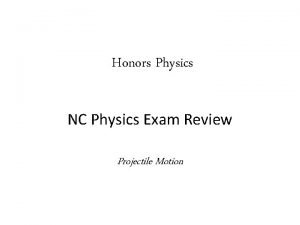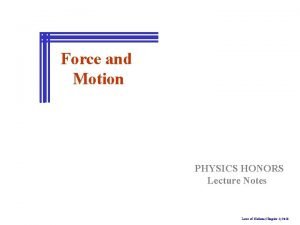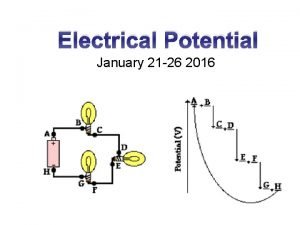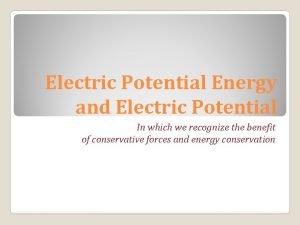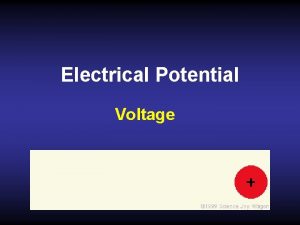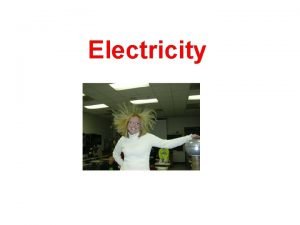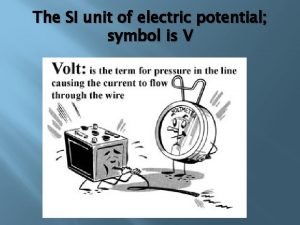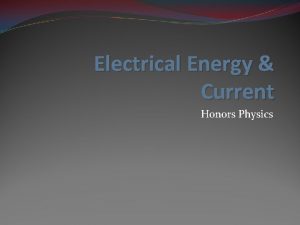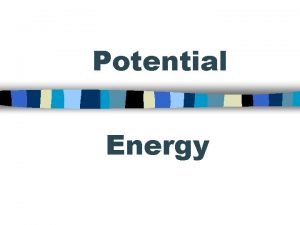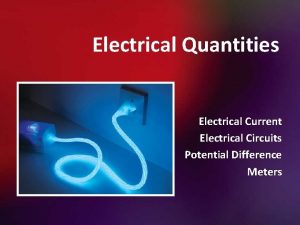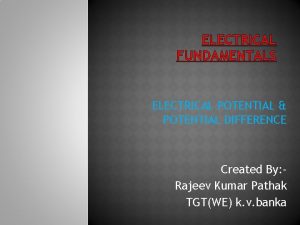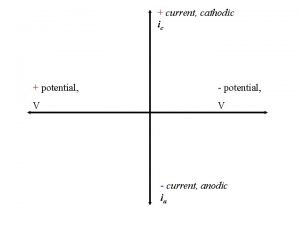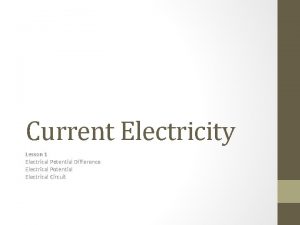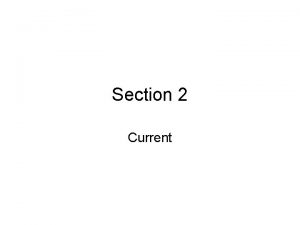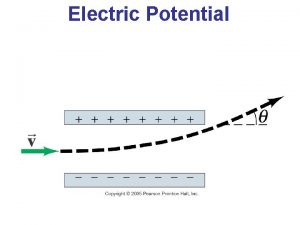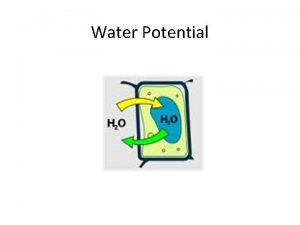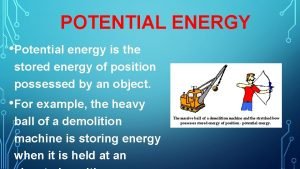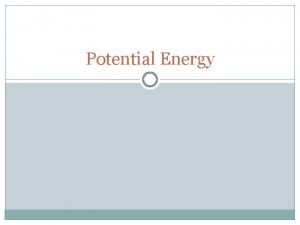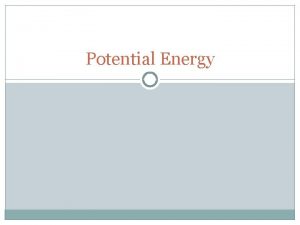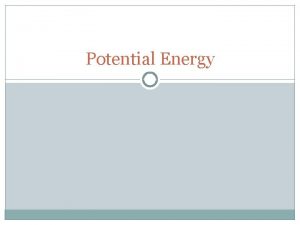Electrical Energy Current Honors Physics Electrical Potential Energy
























































- Slides: 56

Electrical Energy & Current Honors Physics

Electrical Potential Energy PE associated with a charge due to its position in an electric field. Analogous to PEg of an object results from its position in a gravitational field (mgh) Is a component of mechanical energy ME = KE + PEgrav + PEelastic + PEelectric

Gravitational Potential Energy Physicsclassroom. com

Similarity of PEelectric and PEg = mgh m is mass g is gravitational field (ag) h is distance above a reference point PEelect = -q. Ed q is charge E is electric field strength d is component of displacement in the direction of the electric field from reference point Using dimensional analysis, what is the unit of PEelect?

Electric Potential Energy & Work Physicsclassroom. com

Electric Potential Energy & Work Physicsclassroom. com

Electric Work Whenever a force moves an object, work is done on the object. When an electric force moves a charge, work is done on that charge. It is the electric field, E, that exerts force on a charge Therefore, the electric field, E, does work on a charge. This results in a change in PEelect.

Electric PE in a Uniform Electric Field A uniform field is one that has the same magnitude and direction at all points, such as between two parallel plates Remember: electric field lines are always directed from away from positive and toward negative

Electric Potential Energy Recall that ΔPE = -W When charge q is released at point a, electric force will move the charge to b, i. e. The electric field does work on the charge q So, the PE of charge a decreases

Electric Potential Energy W = Fd Since F = q. E (remember E = F/q) W = q. Ed PEb-PEa= -q. Ed ΔPE = -q. Ed Significance of the (-) sign: PEelect Increases if charge is (-) Decreases if charge is (+)

PE as a charge moves in a uniform electric field Movement of charge + charge - charge Along E Loses PE Gains PE Opposite E Gains PE Loses PE ΔPE = -q. Ed Negative sign indicates that PE will increase if the charge is negative and decrease if the charge is positive

Potential Energy between two charges

Learning check When a negative charge moves in the direction of an electric field it gains PE (T/F). When a positive charge moves against the electric field it loses PE (T/F) In order for a negative charge to lose PE, it must move (with/against) the electric field. The change in PE of a charge is equal to –q. Ed (T/F)

Potential Difference Electric potential (V) is the ratio of PEelect to charge q Represents the work needed to move a charge against electric forces from a reference point to some other point in an electric field, divided by the charge W = Fd = q. Ed The SI units of electric potential are what? Which is a …?

Potential difference The change in electric potential The difference in electrical potential between two points Is the work that must be done against electric forces to move a charge from one point to another divided by the charge Is the change in energy per unit charge

Potential Difference Unit is the volt (V) Remember: PEelect is a quantity of energy Electrical potential is a measure of energy per unit charge Potential difference describes change in energy per unit charge

Potential Difference in a Uniform Electric Field Varies in a uniform field with displacement from a reference point Where d is displacement parallel to the field Use this equation to determine potential difference between two points in a field

Potential Difference at a Point Near a Charge One point is near the charge The other point is at infinity

Sample Problem As a charge moves xa = 4. 0 cm to xb = 6. 0 cm in a uniform field of 350 N/C, it loses 4. 5 x 10 -16 J of potential energy. What is the magnitude of the charge? 3. 2 x 10 -17 C What is the potential difference between the two points a and b? -14. 0 V

Electric potential due to multiple charges Electric potentials are scalar quantities (whew!) So…. Total potential at some point in a field is the simple sum of the potentials due to each charge Keep track of signs!

Summary of Formulas ΔPE = -q. Ed

17. 2 Capacitance Capacitors are devices that store electrical PE Often constructed of parallel metal plates When connected to a battery, the plates become charged When fully charged, ∆Vcap = ∆Vbat

Schematic Representation of a Capacitor and Battery Intro to Capacitor

Construction of a Capacitor Parallel plates separated by an insulator (dielectric material) rolled into a cylinder saves space

Capacitance Ability of a conductor to store energy in the form of separated charges Unit of capacitance is the Farad, named for Michael Faraday 1 F = 1 C/V 1 Farad is a large amount of capacitance so… Often use p. F, n. F, or µF Supplemental instruction on capacitance View on your own, ~ 17 min.

Capacitance of a Parallel-Plate Capacitor in a Vacuum When no material exists between the plates ε 0 is the permittivity of the medium between the plates A measure of ability to develop an electrical field, permitting transfer of charges ε 0 in a vaccuum is 8. 85 x 10 -12 C 2/Nm 2

Dielectric Materials placed between the plates of a capacitor can increase capacitance. Typically these are insulating materials

Dielectric Constants (K) Dielectric materials have different values of “dielectric constant” (K). Increase capacitance

Performance of Dielectric Materials Molecules of the dielectric are polarizable As charge builds on the capacitor plates, dielectric molecules orient to the electric field This effectively reduces the charge on the plates…. allowing more charge to be carried by each plate

Capacitor Discharge The opposite of charging, releasing stored charge Electrical potential of the capacitor is used to do electrical work such as … The flash of a camera Signaling the stroke of a computer keyboard

Capacitance of a Sphere R is radius Because the earth has a large radius, it has a very large capacitance i. e. , the earth can accept or supply a very large amount of charge without changing its electrical potential This is why the earth is “ground, ” (reference point for measuring potential differences)

Energy and Capacitors Because work is done to move charges to and from opposite plates… A charged capacitor holds electrical potential energy PE stored in a charged capacitor is equal to the (–) work done to charge it

Breakdown voltage Voltage at which discharge begins, i. e. charges move

Energy and Capacitors PE Stored in a Charged Capacitor

Current and Resistance Current is the rate of movement of charge Rate of movement of electrons through a crosssectional area

Sample Problem If current flowing through a light bulb is 0. 835 A, how long does it take for 1. 67 C of charge to pass through the filament of the bulb? 2. 00 seconds

Conventional Direction of Current Depending upon the circumstances, either positive, negative, or both can move. Particles that move are called charge carriers By convention, direction of current is defined as the direction a positive charge moves or would move if it could. In metals, only electrons can move. Good conductors permit charge carriers to move easily Electrons in metals Ions in solution (electrolytes)

Conventional Direction of Current

Drift Velocity http: //www. bbc. co. uk/staticarchive/4 e 6786539008 e 5012 ff 9 c 723 c 4255 ae 6 fc 6 c 1 b 9 f. gif Recall the structure of metals Valence electrons move about randomly due to their thermal energy Their net movement is zero But if an electric field is established in the wire, there is a net movement of electrons against the electric field (toward +) Drift velocity animation (for enrichment)

Drift Velocity Consider motion of an electron through a wire It is the electric field that exerts force and thereby sets charge carriers in motion (E = F/Q) E propagates very rapidly (near speed of light) Charge carriers move more slowly, in an erratic path, Called drift velocity Slow: e. g. in a copper wire carrying a 10. 0 A current, vdrift = 0. 246 mm/s

Relationship of Voltage and Current: Conductance and Resistance http: //s 3. amazonaws. com/answer-board-image/c 8 b 9 a 2 d 5 -43 d 2 -40 b 4 -a 578 -1874 d 002386 f. gif

Resistance to Current Opposition to electric current Unit of electrical resistance is the ohm (Ω) More commonly known as Ohm’s law

Ohmic and Non-ohmic Materials which follow ohm’s law are ohmic materials Resistance is constant over a wide range of potential differences (linear) Non-ohmic materials have variable resistance (non-linear) Diodes are constructed of nonohmic materials

Other Factors Affecting Resistance

Function of Resistance From Ohm’s Law, changing resistance can change current So, if current needs to be reduced in a circuit, you can increase the resistance In many cases, ∆V is constant, so changing resistance is the only option for reducing current.

Electrical Resistance in the Body Electrical resistance is reduced as the body becomes wet or sweats This is due to the greater availability of ions to conduct current Practical applications: Your body is more susceptible increased current when wet Lie detectors EKGs, etc

Potentiometers Devices that have variable resistance “Pots” Applications Control knobs on electronic devices Stereos, dimmer switches, joy sticks, etc.

17. 4 Electric Power A potential difference (∆V) is necessary to cause current (I) Batteries supply chemical energy (PEchem) which can be converted into PEelect Generators convert mechanical energy into electrical Peelect E. g. hydroelectric power plants Wind turbines Coal or natural gas power plants Nuclear power plants Solar power Geothermal energy

Direct and Alternating Current DC current flows in one direction only Electrons move toward the (+) terminal Conventional current directed from (+) to (-) AC current Terminals of source of ΔV constantly switch Causing constant reversal of current, e. g. 60 Hz Rapid switching causes e-s to vibrate rather than have a net motion.

DC and AC DC constant uni-directional AC not constant bi-directional

Energy Transfer In a DC circuit Electrons leave the battery with high PE Lose PE as flow through the circuit Regain PE when returned to battery (battery supplies PE through electrochemical reactions)

Internal structure of a dry cell http: //static. sfdict. com/dictstatic/dictionary/graphics/ahsd/jpg/ASbatter. jpg

Electric Power The rate of conversion of electrical energy SI unit is the watt (W)

Other Formulas for Power

Kilowatt-hours How utility companies measure energy consumed Is the energy delivered in one hour a constant rate of one k. W 1 k. Wh=3. 6 x 106 J What is the cost to light a 100 W light bulb for 1 full day if the electric utility rate is $0. 0600 per k. Wh?

Transmission Lines P=I 2 R Current and resistance result in energy loss during transmission. P=IΔV This loss is counteracted by transmitting at low current or high voltage Transmission lines may operate at up to 765 k. V
 Power equation
Power equation Honors physics semester 2 review
Honors physics semester 2 review Honors physics projectile motion test
Honors physics projectile motion test Physics honors notes
Physics honors notes Unit of potential
Unit of potential Electric potential
Electric potential Electric potential and potential energy
Electric potential and potential energy If a battery provides a high voltage it can
If a battery provides a high voltage it can Electrical potential energy
Electrical potential energy Electron volt to volt
Electron volt to volt Physics 03-01 work and the work-energy theorem
Physics 03-01 work and the work-energy theorem Kinetic energy in gravitation
Kinetic energy in gravitation Elastic potential energy
Elastic potential energy Example of mechanical energy
Example of mechanical energy Gravitational potential energy vs kinetic energy
Gravitational potential energy vs kinetic energy The law of conservation of energy states that
The law of conservation of energy states that Potential energy meaning
Potential energy meaning Mechanical energy conservation
Mechanical energy conservation Kinetic energy and potential energy formula
Kinetic energy and potential energy formula Conservation of mechanical energy
Conservation of mechanical energy Flaccid cell
Flaccid cell Water potential definition biology
Water potential definition biology Solute potential equation
Solute potential equation Neuronal pool
Neuronal pool Nerve action potential
Nerve action potential Graded potential definition
Graded potential definition Graded potential vs action potential
Graded potential vs action potential Graded vs action potential
Graded vs action potential Osmotic potential vs water potential
Osmotic potential vs water potential Source of bioelectric potential
Source of bioelectric potential End-plate potential vs action potential
End-plate potential vs action potential Rocuronium dose
Rocuronium dose Action potential resting potential
Action potential resting potential Action potential resting potential
Action potential resting potential Difference between sales potential and market potential
Difference between sales potential and market potential Define electric potential and potential difference.
Define electric potential and potential difference. Electric potential inside non conducting sphere
Electric potential inside non conducting sphere Electric potential from electric field
Electric potential from electric field Electrostatic potential
Electrostatic potential Current potential difference and resistance
Current potential difference and resistance Y connected generator
Y connected generator Line current and phase current
Line current and phase current Drift current and diffusion current
Drift current and diffusion current Line current and phase current
Line current and phase current Drift vs diffusion current
Drift vs diffusion current Ceramic composition resistors
Ceramic composition resistors The value of vgs that makes is approximately zero
The value of vgs that makes is approximately zero Wye delta diagram
Wye delta diagram Infineon
Infineon Drift current density unit
Drift current density unit Which electrode is positive
Which electrode is positive Hazard based safety engineering
Hazard based safety engineering Non planar circuit
Non planar circuit How to convert mechanical energy to electrical energy
How to convert mechanical energy to electrical energy How do electric motors work
How do electric motors work What is the symbol for potential difference?
What is the symbol for potential difference? Electric field strength formula
Electric field strength formula


